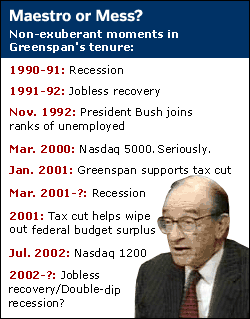NEW YORK (CNN/Money) -
Federal Reserve Chairman Alan Greenspan, despite his recent protests to the contrary, recognized the stock-market bubble in the late 1990s and even weighed taking action against it, according to information uncovered by a private research firm.
In a speech last month about economic volatility, the central bank chairman -- partially in response to growing criticism that he and his fellow policy makers had failed to correct swollen stock prices, the collapse of which helped cause a recession -- said the Fed was never sure there actually was a stock-market bubble.

"It was very difficult to definitively identify a bubble until after the fact -- that is, when its bursting confirmed its existence," Greenspan said.
But the Financial Markets Center (FMC), a private research firm in Philomont, Va., reviewed transcripts of prior Fed policy meetings and found that Greenspan and other policy makers had identified an equity bubble as early as Sept. 24, 1996.
"While it is not so large as to exert undue pressure on the real side of the U.S. economy, this emerging bubble is nonetheless real," said Lawrence Lindsey, then a Fed governor and currently a key economic adviser to President Bush, according to minutes of the meeting.
"As in the United States in the late 1920s and Japan in the late 1980s, the case for a central bank ultimately to burst that bubble becomes overwhelming," Lindsey added.
"I recognize that there is a stock market bubble problem at this point," Greenspan replied, "and I agree with Governor Lindsey that this is a problem that we should keep an eye on."
Shortly after that meeting, on Dec. 5, 1996, Greenspan made the famous speech in which he wondered, "[H]ow do we know when irrational exuberance has unduly escalated asset values, which then become subject to unexpected and prolonged contractions as they have in Japan over the past decade?"
The speech caused a temporary shock in the stock market, as traders worried Greenspan was warning of a stock bubble. But it might have simply been an expression of Greenspan's internal struggle to figure out if there a bubble existed or not.
Fed historian Allen Meltzer, a Carnegie Mellon professor and founder of the Shadow Open Market Committee, which studies monetary policy, said Greenspan changed his mind after 1996 about the possibility that stocks were overpriced.
"After 1996, he recognized there had been a productivity change," Meltzer said. "[Stock prices] rose because people believed there was productivity improvement -- and there has been. The thing that turned out to be wrong was that productivity has not been profitable."
Click here for more on the Fed and rates
But is having the Fed chairman change his mind about such a critical issue desirable?
"The problem with the Greenspan Fed is that it has been a 'make it up as you go along' Fed," said Jim Bianco, president and research director of BiancoResearch.com. "There is no philosophy with Greenspan. He changes his mind about all of this stuff."
Bianco pointed out that Greenspan has also changed his mind about one possible remedy for the bubble -- manipulation of margin requirements.
In the Sept. 24, 1996, policy meeting, Greenspan said he wasn't sure raising short-term interest rates, the Fed's most potent policy tool, would be of much help in dealing with the bubble. And, in fact, the Fed left rates alone at that meeting.
But many Fed critics have charged that the Fed could have raised lending requirements for margin trading in stocks. Margin trading, which is essentially buying stocks on credit, often helps fuel speculative booms.
In several speeches in recent years, Greenspan has dismissed the effectiveness of raising margin requirements.
"There is no evidence to suggest margin requirements have an effect on stock prices," he said in response to a question at a Jan. 13, 2000, speech.
In his August speech about economic volatility, Greenspan amended that idea, saying raising margin requirements might impact stock prices, but only if traders believed the higher margin requirements would be followed by a rise in short-term interest rates.
| |
 Related stories
Related stories
| |
| | |
| | |
|
In 1996, however, Greenspan seemed to have a totally different view of the impact of higher margin requirements.
"We do have the possibility of raising major concerns by raising margin requirements," he said in the Sept. 24, 1996 meeting. "I guarantee you that if you want to get rid of the bubble, whatever it is, that will do it. My concern is that I am not sure what else it will do."
The Fed declined to comment on any of the issues raised by the Sept. 24 transcript.
The FMC, in a release on its Web site, said, "While it seems unlikely that margin adjustments alone are capable of remedying all stock-market imbalances, the Fed has yet to provide a convincing explanation for its decision to leave margin requirements untouched during one of the greatest asset bubbles in U.S. history."

|

